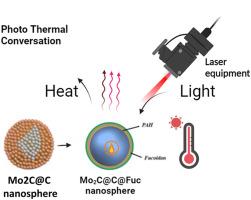核壳 Mo₂C@C@Fucoidan 纳米球的光热和光动力响应
IF 4.3
3区 材料科学
Q2 MATERIALS SCIENCE, MULTIDISCIPLINARY
引用次数: 0
摘要
Mo2C 结构是一种过渡金属碳化物,以其优异的性能而闻名,包括高化学稳定性、热稳定性和表面活性。最近,碳修饰的 Mo2C 结构因其有效性而得到广泛应用。在此,我们合成了石榴状 Mo2C@C 纳米球,并在其表面涂覆了聚(烯丙胺盐酸盐)(PAH)和褐藻糖胶结构。表征技术包括 FE-SEM、HR-TEM、XRD、XPS 和 zeta 电位分析。我们通过定量评估 Mo2C@C@Fuc 纳米球的光热转换效率来研究其效果。在波长为 808 nm 和 1064 nm、功率强度为 2 W/cm2 的激光照射下,这些纳米球可将高达 15% 的入射激光能量转化为热量,优于传统材料。在各种生理酸碱度环境下进行的稳定性测试证实了它们在近红外辐照下的耐久性,从而确保了在生物环境中的操作完整性。此外,它们在产生单线态氧方面表现出显著的效率,使其成为有前途的光导治疗剂。生物降解研究表明,它们在治疗应用后可安全降解,突出了它们在环境和生理方面的兼容性。将 Mo2C@C@Fuc 纳米球融入抗癌策略中,结合了 PTT 和 PDT 的优势,有望改善治疗效果并具有高度的生物兼容性。本文章由计算机程序翻译,如有差异,请以英文原文为准。

Photothermal and photodynamic responses of core-shell Mo₂C@C@Fucoidan nanospheres
Mo2C structure, a transition metal carbide, is known for its exceptional properties including high chemical and thermal stability and surface activity. Recently, carbon-modified Mo2C structures have found widespread applications due to their effectiveness. Here, we synthesized pomegranate-like Mo2C@C nanospheres and coated them with poly(allylamine hydrochloride) (PAH) and fucoidan structures. Characterization techniques including FE-SEM, HR-TEM, XRD, XPS, and zeta potential analysis were employed. We investigated the effect of Mo2C@C@Fuc nanospheres by quantitatively evaluating their photothermal conversion efficiency. Under irradiation at wavelengths of 808 nm and 1064 nm with a power intensity of 2 W/cm2, these nanospheres could convert up to 15 % of the incident laser energy into heat, outperforming conventional materials. Stability tests in various physiological pH environments confirmed their durability under NIR irradiation, ensuring operational integrity in biological environments. In addition, they showed significant efficiency in the production of singlet oxygen, making them promising agents for PDT. Biodegradation studies indicated safe degradation after therapeutic application, highlighting their environmental and physiological compatibility. Integrating Mo2C@C@Fuc nanospheres into anticancer strategies combines the advantages of PTT and PDT, promising improved therapeutic outcomes with high biocompatibility.
求助全文
通过发布文献求助,成功后即可免费获取论文全文。
去求助
来源期刊

Materials Chemistry and Physics
工程技术-材料科学:综合
CiteScore
8.70
自引率
4.30%
发文量
1515
审稿时长
69 days
期刊介绍:
Materials Chemistry and Physics is devoted to short communications, full-length research papers and feature articles on interrelationships among structure, properties, processing and performance of materials. The Editors welcome manuscripts on thin films, surface and interface science, materials degradation and reliability, metallurgy, semiconductors and optoelectronic materials, fine ceramics, magnetics, superconductors, specialty polymers, nano-materials and composite materials.
 求助内容:
求助内容: 应助结果提醒方式:
应助结果提醒方式:


